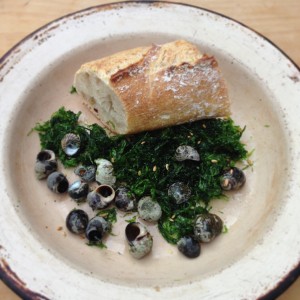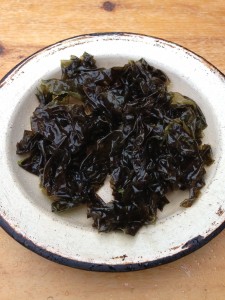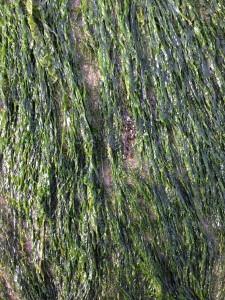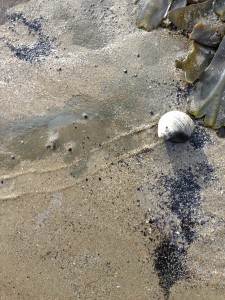It is still a little early for harvesting some coastal plants and seaweeds, but there’s certainly enough growing by March to make it well worth a trip to the seaside.
When you get there, having checked the tide times, have a look along the foreshore for some edible seaweeds. There are hundreds of varieties growing around our shores, and yet they have to be one of our most overlooked wild foods. Luckily, the three inedible types only grow in deep water, so they pose us no threat. I’m going to mention two types of seaweed you can find at the moment – both are very common, easy to identify and don’t need much preparation.
Laver.
Traditionally used by the Welsh to make laver bread, and often served with cockles or clams, in Japan Laver is transformed into Nori, the paper-like wrap for sushi. Laver is available all year round and best harvested when the tide is going out so it hasn’t yet picked up any grit.
This purple-brown seaweed is easy to recognise – it looks like an assortment of shredded plastic bags draped over the rocks! Granted, seaweed might not appear the most appetising of foods, but get involved and I promise you won’t be disappointed…
First, wash the laver thoroughly, then add to a pan of water and bring to the boil. Simmer for an hour or so, then strain.
In a small frying pan, cook some bacon medallions. Fry the mushrooms separately, then add the laver and mushrooms to the pan you cooked the medallions in.
Crack two eggs on top of the mixture and place under the grill for a few minutes until the eggs are cooked.
That’s it… Enjoy!
Winkles or Periwinkles.
These travel fast, and are not easy to catch! However, on a recent coastal foray I did manage to chase down one or two. As with seaweed, these gastropods are often overlooked, but they’re delicious, with or without accompaniment, and well worth the small amount of time it takes to remove them from their shells. You can find winkles all along the coasts of Britain, on rocks and mudflats where they feed on seaweed. Though very common, they breed during the summer, so best not disturb them at this time.
Winkles with crispy seaweed:
Rinse and soak the winkles in salted water half an hour before cooking.
Bring them to the boil in a pan and simmer for three or four minutes.Let them cool down a little. You will need something to remove them from their shells – I use a sewing needle – and discard the hard foot at the top end. People often dip them in malt vinegar, but I like them as they are, with just the saltwater they’re cooked in.
To make the crispy seaweed, first rinse it well to remove sand and other unwanted ingredients, and then dry it thoroughly. To cook, heat oil approximately 5cm deep in a heavy-based saucepan. Fry in batches and cook for five to six seconds – Gutweed pops and explodes when deep fried, so stand well clear!
Remove and place on kitchen paper to drain.
You can then add a pinch of sugar and maybe a little sesame oil or toasted sesame seeds if you like. Delicious.
This works well as a side dish, or as a condiment to sprinkle on fish or a stir-fry.
Seaweeds are packed full of goodness – they contain protein, carbohydrate, iron, iodine, and antioxidants. They taste great in stir fries, risottos and soups, or you can dry them and add to various dishes, so why not give some of these scrumptious seashore treats a try?
In another post I’ll tell you about a few more of my favourite seashore pickings. The highly versatile Sea Spinach will definitely be one of them.
A few good books I recommend are:
Wild Food by Roger Phillips
Eat the Beach by Fraser Christian
Edible Seashore by John Wright
http://www.wild-food.net/book/8/Seashore




